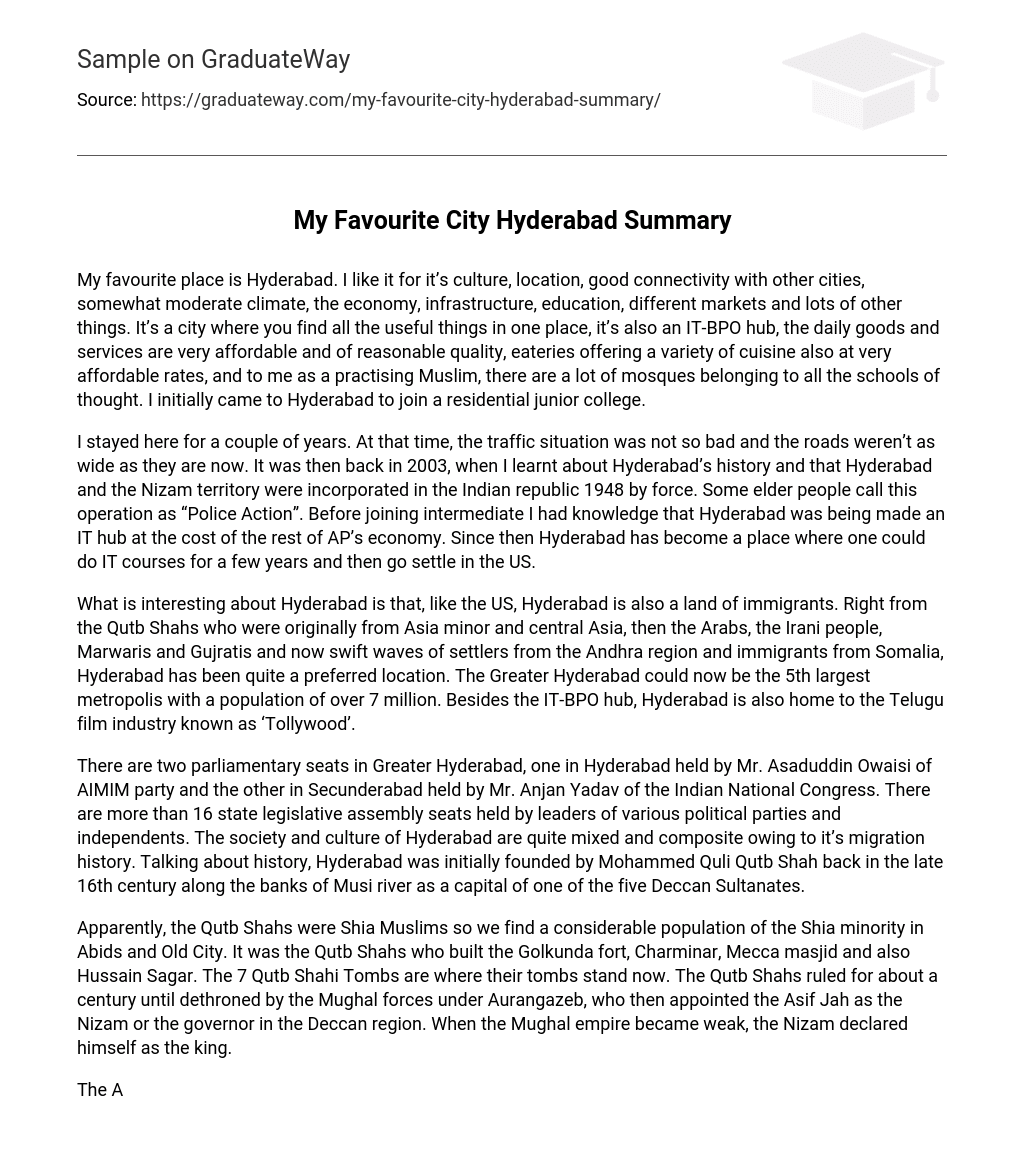My favourite place is Hyderabad. I like it for it’s culture, location, good connectivity with other cities, somewhat moderate climate, the economy, infrastructure, education, different markets and lots of other things. It’s a city where you find all the useful things in one place, it’s also an IT-BPO hub, the daily goods and services are very affordable and of reasonable quality, eateries offering a variety of cuisine also at very affordable rates, and to me as a practising Muslim, there are a lot of mosques belonging to all the schools of thought. I initially came to Hyderabad to join a residential junior college.
I stayed here for a couple of years. At that time, the traffic situation was not so bad and the roads weren’t as wide as they are now. It was then back in 2003, when I learnt about Hyderabad’s history and that Hyderabad and the Nizam territory were incorporated in the Indian republic 1948 by force. Some elder people call this operation as “Police Action”. Before joining intermediate I had knowledge that Hyderabad was being made an IT hub at the cost of the rest of AP’s economy. Since then Hyderabad has become a place where one could do IT courses for a few years and then go settle in the US.
What is interesting about Hyderabad is that, like the US, Hyderabad is also a land of immigrants. Right from the Qutb Shahs who were originally from Asia minor and central Asia, then the Arabs, the Irani people, Marwaris and Gujratis and now swift waves of settlers from the Andhra region and immigrants from Somalia, Hyderabad has been quite a preferred location. The Greater Hyderabad could now be the 5th largest metropolis with a population of over 7 million. Besides the IT-BPO hub, Hyderabad is also home to the Telugu film industry known as ‘Tollywood’.
There are two parliamentary seats in Greater Hyderabad, one in Hyderabad held by Mr. Asaduddin Owaisi of AIMIM party and the other in Secunderabad held by Mr. Anjan Yadav of the Indian National Congress. There are more than 16 state legislative assembly seats held by leaders of various political parties and independents. The society and culture of Hyderabad are quite mixed and composite owing to it’s migration history. Talking about history, Hyderabad was initially founded by Mohammed Quli Qutb Shah back in the late 16th century along the banks of Musi river as a capital of one of the five Deccan Sultanates.
Apparently, the Qutb Shahs were Shia Muslims so we find a considerable population of the Shia minority in Abids and Old City. It was the Qutb Shahs who built the Golkunda fort, Charminar, Mecca masjid and also Hussain Sagar. The 7 Qutb Shahi Tombs are where their tombs stand now. The Qutb Shahs ruled for about a century until dethroned by the Mughal forces under Aurangazeb, who then appointed the Asif Jah as the Nizam or the governor in the Deccan region. When the Mughal empire became weak, the Nizam declared himself as the king.
The Asif Jahi dynasty or the Nizams ruled here for 7 generations spanning more than 200 yrs. Hyderabad was a princely state under the British rule till 1948. Hyderabad is among the few cities in India with a relatively higher percentage of Muslim population and so retains many social values of the Muslim culture. Until the year 2000, Hyderabad was just another state capital of India. But as Hyderabad became a hub of IT-BPO industry the population has doubled in the past 10 yrs which makes it the fastest growing city in India.
Because of this rapid increase in population, Hyderabad has been increasingly facing the problems of water shortage, waste management and traffic congestion. Hyderabad is sometimes called as the city of rocks or the city of pearls. City of rocks because we see a lot of rocky hills around the city; and city of pearls because it is one the largest pearl producer cities in India. Hyderabad is known for its Qutb Shahi and Nizami culture. One of the most remarkable aspects of the Hyderabadi culture is the Hyderabadi Urdu dialect, which is easily identifiable from other dialects.
Hyderabad is also known for its Persian influenced cuisine which include Biryani, Haleem and Irani chai. There are beautiful tourists locations like Salar Jung Museum, Falaknuma, Chaomahalla and King Kothi Palaces, Purani Haveli, Golkunda fort, Charminar, Mecca Masjid, Ramoji Film City, Birla Temple and others. The Nizams have contributed a lot to this city. Some of the institutions built by the Nizams have now become Government institutions, like the High Court, Osmania University and Salar Jung Museum. The Falknuma Palace has been ransformed into a super luxury Heritage Hotel, now owned by the Taj Group. Jamia Nizamia a well known Islamic university, the lakes of Osmansagar and Himayat Sagar and the present drainage system of Hyderabad were all built during the Nizam rule. There’s a beautiful lake in the middle of the city known as Hussain Sagar which was built by the Qutb Shahs. It is surrounded by many parks, gardens and wide roads which offer nice drives of which Necklace road is the best stretch. Unfortunately Hussain Sagar is not being maintained well by the government and so has become dirty and gives a foul smell.
When Chandrababu Naidu became the chief minister, he started to bring IT investors to Hyderabad. Since then, Hyderabad has become a major IT-BPO hub in India. The Cyber Towers at Madhapur stand as an icon of this rapid transformation of the city into an IT hub. The HITEC City now has offices of several domestic and international IT and BPO companies. Due to this rapid growth Hyderabad has become the single largest contributor to the GDP of AP state. So… that’s a summary about Hyderabad.





